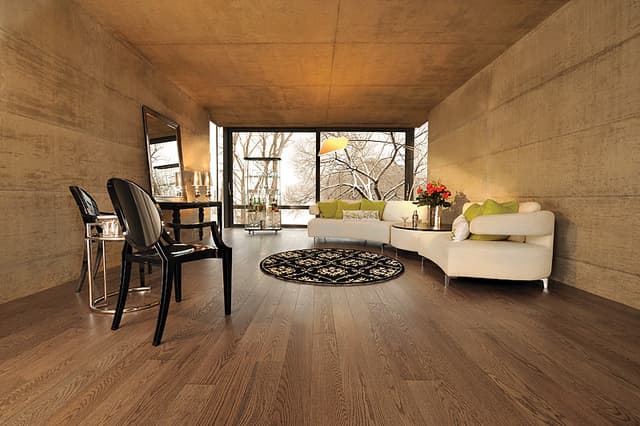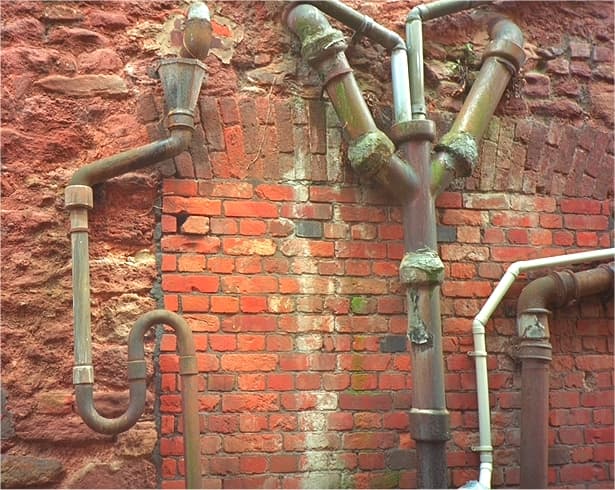Prefinished Flooring - Key Benefits and Advantages
By Editorial Team
Updated on March 31, 2025

Have you ever asked yourself why 85% of the flooring sold in North America is prefinished? Research shows that this sort of flooring is greatly preferred and a popular choice on account of its slew of advantages.
How does prefinished flooring differ from standard, unfinished flooring? What are the product’s key benefits in terms of durability, proper care, and installation? Is it the best option for your renovation project?
Learn everything you need to know about prefinished flooring in this article, including product-specific characteristics and why it’s become a staple in North American homes.
The Top 8 Advantages of Prefinished Wood Flooring

Source : Construction Mirador
1. Quick and easy installation
Prefinished flooring doesn’t need to be:
Varnished
Sanded
Oiled
Once installed, this type of flooring is user-ready.
2. Hardwood with a long-lasting finish
Prefinished flooring is coated in a varnish made with:
Several layers of UV-cured urethane
Aluminum oxide crystals
Anti-yellowing agent
Anti-microbial protective layer
The combination of products listed above is both wear- and shock-resistant, courtesy of the film’s hardness, which is applied in-factory. The use of aluminum oxide crystals enables this level of resistance. Aluminum oxide crystals rank 9 on the Mohs Hardness Scale, listed right below diamonds, the hardest material known to man.
It’s rather straightforward: the higher the levels of aluminum oxide crystals found in prefinished flooring, the harder the protective layer and the more resistant the surface becomes to wear and tear. Albeit the protective layer is hard, it’s still flexible, which prevents the finish from cracking or chipping when the wood expands or shrinks.
3. Strong adhesive capability
When it comes to prefinished flooring, the most important feature is its protective coating, which adheres to the wood, no matter what. The latter explains why a protective coating made up of several layers of urethane is preferred.
In this specific composition, every layer has distinctive properties, including adhesion performance. It also prevents the protective coating from breaking apart after repetitive scrubbing, which flooring naturally undergoes.
A well-adhering protective coating enhances a prefinished floor's scratch resistance.
4. UV ray- and scratch-resistant
Scratch and abrasion resistance relies on a meticulous balance between the urethane layers’ flexibility and hardness.
Flooring finishing manufacturers can combine hardness and flexibility by adjusting the cross-link density, which refers to the number of cross-links between each polymer, and the transition temperature.
Here’s the rule: The more flexible the monomers found in the urethane layers, the weaker the scratch and abrasion resistance.
5. Great flexibility
Prefinished flooring is extremely flexible. This finish-specific property makes it more or less vulnerable to:
Cracks
Chips
The latter is actually an ongoing debate amongst varnish manufacturers and lumber producers.
The former considers that cracking or chipping in the flooring’s finish is a direct result of the wood’s humidity level, while the latter points to the use of aluminum oxide crystals found in the mixture as the cause.
Truth is, both parties are right. And it’s exactly what causes problems in some woods, such as white oak (Quercus alba), red oak (Quercus rubra), and jatoba (Hymenaea courbaril), which are the most affected wood species. Not to mention that oak represents at least 50% of the flooring market.
As a result, to benefit from the flexibility of floor varnish, prefinished flooring manufacturers not only have to apply the right mixture but also do so on floorboards that are dried accordingly.
6. Visually appealing
Adding an anti-yellowing agent in the finish widely contributes to a prefinished flooring’s aesthetic. Also, the number of urethane layers found in the protective layer adds to the quality of the finish. Depending on the manufacturer, there can be 6 or 9 layers.
7. Several finishes
Evolving techniques make it possible to select a specific look:
Polished
Weathered/aged
Oiled
Waxed
There’s also a slew of different hues to choose from, ranging from lighter to darker shades, with warm and cold colours in between.
8. Low maintenance
A broom and a mop are the only tools you should use to clean a prefinished floor.
To maintain its gloss, polish the flooring one to two times a year, helping preserve its original appeal.
How to Protect Hardwood & Solid Wood Floors for a Glossy Appeal

Source : Soumission Rénovation
Maintenance is key, and it’s synonymous with regularity. Hardwood floors aren’t solely damaged by dust particles coating their surface. Hardwood surfaces collect cooking grease and others, which can cause slips and falls. And, a poorly maintained floor will be much harder to clean and remove grease stains.
There are three ways to clean hardwood floors for a glossy finish:
Dry cleaning
Damp cleaning
Soak cleaning
You can dry clean hardwood floors using a mop equipped with a microfibre towel in well-kept areas. You can do so daily.
Damp cleaning is reserved for fairly clean surfaces, or when you don’t have time to carry out a soak cleaning. Just use a slightly wrung mop.
Carrying out a soak cleaning is the only way to remove deeply ingrained greasy substances. Use a mop completely soaked with both water and floor cleaner. Start with an initial mopping, then wring out the mop. Mop again to remove the cleaner before the floor dries. Otherwise, the flooring will stay coated in a layer of cleaner.
What Are the Most Resistant Hardwoods?
Generally speaking, hardwood encompasses all dense woods, such as oak, beech, ash, and maple. Hardwood is a preferred flooring material on account of its:
Wear resistance
Durability
Aesthetic
White Oak
Typically, one doesn’t opt for a specific flooring based on visual appeal alone, its overall resistance also comes into play. As mentioned about varnish, hardness guarantees the flooring’s durability and wear resistance.
Oak takes the lead here—but not all types of oaks, so be careful! If you were to consider the Janka Hardness Test, which determines the durability of specific wood species, white oak measures in at 1820.
As for red oak, it comes in under at 1290, ranking below maple, but here again, not all types of maples.
Maple Floor
We’ll look at two different types of maples:
Maple wood
Silver maple wood
According to the Janka scale, maple wood measures in at 1450, meaning it’s more resistant than ash (1320) or cherry (1260), however, silver maple doesn’t measure over 950 on the hardness scale, just like cherry wood, but then again, Brazilian cherry wood ranks very high.
As a result, it’s best to stick to hardwood flooring made with white oak- or maple-derived lumber, above all else.
FAQ About Prefinished Flooring
How can you tell if a floor is well-maintained?
Check if your flooring is cracked, warped, excessively squeaky, or sagging in some areas. A well-maintained floor is solid and uniform and shows no signs of moisture build-up or visible wear.
What’s the difference between hardwood and parquet floors?
The term hardwood is commonly employed to pinpoint solid wood floorboards made with high-quality wood, such as oak or maple. Whereas, parquet flooring is nothing but an assembly of leftover or scrap wood.
What does prefinished flooring mean?
Prefinished or pre-varnished refers to flooring that has been sanded, stained, and sealed before installation, offering a ready-to-install solution with a polished finish.
How long do prefinished hardwood floors last?
With proper maintenance, prefinished flooring can last a lifetime—or as long as your home. Warranties typically range from 10 to 100 years, but mostly fall in the 25-year range, though they don't cover issues like dents, warping, gapping, or surface scratches.
What are the disadvantages of prefinished hardwood floors?
While prefinished hardwood floors have a slew of upsides, they aren't without some drawbacks. Repairs are challenging since new sections may not blend seamlessly. The surface, though durable, can still dent or scratch easily. And, refinishing is difficult or sometimes impossible due to the factory-applied finish and thinner wear layer.
Looking for something else?
Related articles
The latest industry news, interviews, technologies, and resources.

Léa Plourde-Archer
•07 Nov 2023
Deciding to replace your current floor is a process that should not be taken lightly. Not only is it a major financial investment, but it also takes time. Which material is best? Which colour?

Editorial Team
•22 Jan 2025
Tiles are crafted with different materials. Having a clear understanding of said materials means choosing aesthetic and hard-wearing wall and floor coverings. Here are 6 of the most used types of tiles, whether indoors or outdoors.

Editorial Team
•17 Oct 2024
Old homes have charm and character that newer homes don’t. But with age comes wear and tear, and renovating an old home can seem like a big (and expensive) job. The good news is, you don’t have to break the bank to turn an old property into a fresh, modern, and functional living space. With a bit of imagination and smart decisions, you can breathe new life into your old home.

Editorial Team
•05 Aug 2024
Taking on a home renovation is a big commitment that involves a large amount of time, stress and money. Hiring a renovation contractor means putting your trust in a stranger, and the trust is serious, as it involves your home. Unfortunately, contractors do not have the best reputation for upholding their end of the bargain.

Editorial Team
•21 Aug 2024
It's impossible for a human being to detect asbestos or lead in plain sight, as neither can be seen or smelt by the human alone. However, both are incredibly dangerous for the health when ingested, and actions must be taken immediately if there is any suspicion of either material.